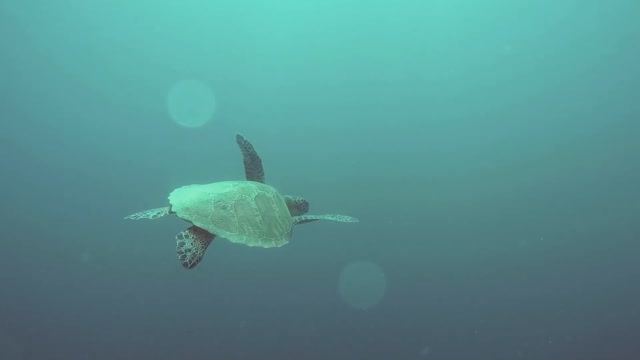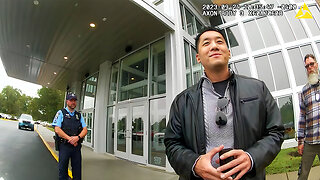Premium Only Content

Scuba Divers Accidently meet Sea Turtle.
Sea turtles (superfamily Chelonioidea), sometimes called marine turtles, are reptiles of the order Testudines and of the suborder Cryptodira. The seven existing species of sea turtles are the flatback, green, hawksbill, leatherback, loggerhead, Kemp's ridley, and olive ridley sea turtles. All six of the sea turtle species present in US waters (all of those listed above except the flatback) are listed as endangered and/or threatened under the Endangered Species Act.The seventh sea turtle species is the flatback, which exists in the waters of Australia, Papua New Guinea and Indonesia. Sea turtles can be separated into the categories of hard-shelled (cheloniid) and leathery-shelled (dermochelyid). There is only one dermochelyid species which is the leatherback sea turtle.
For each of the seven types of sea turtles, females and males are the same size; there is no sexual dimorphism.
In general, sea turtles have a more fusiform body plan than their terrestrial or freshwater counterparts. This tapering at both ends reduces volume and means that sea turtles cannot retract their head and limbs into their shells for protection, unlike many other turtles and tortoises. However, the streamlined body plan reduces friction and drag in the water and allows sea turtles to swim more easily and swiftly.
The leatherback sea turtle is the largest sea turtle, measuring 2–3 m (6–9 ft) in length, 1–1.5 m (3–5 ft) in width, and weighing up to 700 kg (1500 lb). Other sea turtle species are smaller, being mostly 60–120 cm (2–4 ft) long and proportionally narrower.[9]
The skulls of sea turtles have cheek regions that are enclosed in bone. Although this condition appears to resemble that found in the earliest known fossil reptiles (anapsids), it is possible it is a more recently evolved trait in sea turtles, placing them outside the anapsids. Sea turtles, along with other turtles and tortoises, are part of the order Testudines. All species except the leatherback sea turtle are in the family Cheloniidae. The superfamily name Chelonioidea and family name Cheloniidae are based on the Ancient Greek word for tortoise: χελώνη (khelone).The leatherback sea turtle is the only extant member of the family Dermochelyidae.
The origin of sea turtles goes back to the Late Jurassic (150 million years ago) with genera such as Plesiochelys, from Europe. In Africa, the first sea turtle is Angolachelys, from the Turonian of Angola.However, neither of these are related to extant sea turtles; the oldest representative of the lineage leading to these was Desmatochelys padillai from the Early Cretaceous.
A lineage of unrelated marine testudines, the pleurodire (side-necked) bothremydids, also survived well into the Cenozoic. Other pleurodires are also thought to have lived at sea, such as Araripemys and extinct pelomedusids. Modern sea turtles are not descended from more than one of the groups of sea-going turtles that have existed in the past; they instead constitute a single radiation that became distinct from all other turtles at least 110 million years ago.
Sea turtles' limbs and brains have evolved to adapt to their diets. Their limbs originally evolved for locomotion, but more recently evolved to aid them in feeding. They use their limbs to hold, swipe, and forage their food. This helps them eat more efficiently
natgeo,animals,wildlife,science,explore,discover,survival,nature,documentary,turtle,sea ,Sea Turtles 101,Sea Turtles,dinosaurs,reptiles survive,time of the dinosaurs,mariners,adaptations
-
 LIVE
LIVE
Barry Cunningham
31 minutes agoPRESIDENT TRUMP EVENTS IN SOUTH KOREA | MIKE JOHNSON SHUTDOWN DAY 29 PRESSER | MORE NEWS!
922 watching -
 2:19:30
2:19:30
Side Scrollers Podcast
4 hours agoAngry Joe’s TDS/Halo Meltdown + Console War is OVER + Twitch Staff FIRED + More | Side Scrollers
7.57K4 -
 1:13:46
1:13:46
DeVory Darkins
2 hours agoDemocrat Voters get CRUSHING NEWS as Trump celebrates MAJOR TRADE DEAL
47.1K28 -
 DVR
DVR
Mark Kaye
2 hours ago🔴 Joe Biden Autopen Scandal Update - Staff Paid MILLIONS To Keep Quiet!
1.24K1 -
 LIVE
LIVE
SternAmerican
1 day agoELECTION INTEGRITY CALL – WED, OCT 29 · 2 PM EST | FEATURING NEW JERSEY
208 watching -
 1:05:34
1:05:34
Timcast
2 hours agoDemocrats SUE, Trump USDA Says ITS DONE, No Food Stamps Will Come, Riots Feared
145K170 -
 1:59:16
1:59:16
The Charlie Kirk Show
2 hours agoProud to Be American? + VA and NJ + Charlie's Education Vision | Maloney, Arnn | 10.29.2025
28.4K7 -
 38:32
38:32
Code Blue Cam
3 hours agoHow Police Stopped a Potential Church Massacre...
221 -
 1:04:24
1:04:24
Sean Unpaved
2 hours agoBLUE JAYS SHOCK THE WORLD: Series Tied!, NFL Deadline Meltdown + NBA's Cup Chaos Begins
3.33K1 -
 LIVE
LIVE
Dr Disrespect
3 hours ago🔴LIVE - DR DISRESPECT - BATTLEFIELD 6 - REDSEC DUOS - WIN WIN WIN
1,923 watching